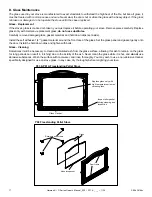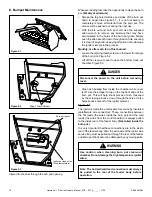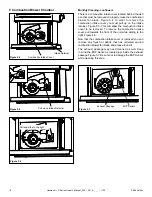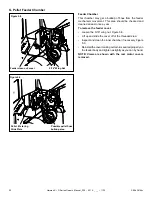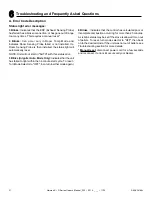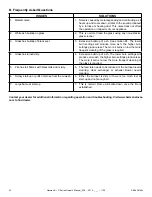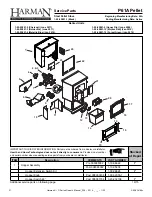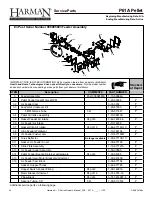
Harman® • P-Series Owner’s Manual_R10 • 2014 - ___ • 11/15
23
3-90-436168c
STOVE DOES NOT FEED
1. No fuel in hopper.
2. Firebox draft may be too low for sensing switch in feeder
circuit to operate.
Check for closed doors
, loose or
missing gasket on doors or hopper lid.
3. Feed motor will not run until the ESP control senses a
certain temperature. Maybe you did not put enough fuel
or starting gel in the burn pot before manually lighting the
fire.
4. Restriction in the hopper or feeder. Remove all fuel and
examine. Clear the obstruction.
5. Feed motor has failed.
PARTIALLY BURNED PELLETS
1. Feed rate too high.
2. Poor air to fuel mixture. (Check burn pot clean-out cover
and air intake).
3. Burn pot or heat exchanger tubes may need to be cleaned.
4. Combination of all the above.
5. #6 status blink: A 6 blink control board status indication
is caused by poor or incomplete combustion. The circuit
board has the ability to track the combustion through feed
settings and ESP temperatures. When the control board
has calculated poor or incomplete combustion, it will shut
down the unit as a safety feature. (Poor or incomplete
combustion is a contributor of creosote which may cause
a chimney fire)
A 6 blink status may be caused by several things:
1. Blocked or partially blocked flue.
2. Blocked or partially blocked inlet air.
a. Backdraft damper on the inlet pipe may be stuck closed.
b. If outside air is installed, the inlet cover may be blocked.
3. The air chamber under the burnpot may be filled with fines
and small bits of ash.
4. The holes in the burnpot may be getting filled with ash or
carbon buildup.
5. Combustion blower fan blades may need cleaned.
6. Fuel restrictions as noted above.
SMOKE SMELL
Seal the vent pipe joints and connection to stove with silicone.
The exhaust vent is the only part of the system that is under
positive pressure.
FIRE HAS GONE OUT- Check for status light.
1. No fuel in hopper.
2. Draft is too low, blocked flue.
3. Something is restricting fuel flow.
4. Hopper lid not closed properly.
5. Feed motor or combustion blower has failed.
SMOKE IS VISIBLE COMING OUT OF VENT
1. Air-fuel ratio is too rich.
a. Feed rate too high.
b. Draft too low caused by a gasket leak.
LOW HEAT OUTPUT
1. Feed rate too low
2. Draft too low because of gasket leak.
3. Poor quality or damp pellets
4. Combination of 1 and 2.
HELPFUL HINTS
1. Cleaning Burn Pot
Whenever your stove is not burning, take the opportunity to
scrape the burn pot to remove carbon buildup. A vacuum
cleaner is handy to remove the residue. Be sure the stove
is cold if you use a vacuum.
Carbon buildup can be scraped loose with the fire burning
using the special tool provided with your stove. Scrape the
floor and sides of the burn pot. The carbon will be pushed out
by the incoming fuel. Always wear gloves to do this.
2. Removing Ashes
Turn the Temp Dial to number 1 approximately 30 minutes
before removing ashes. This will result in a cooler stove and
ash pan.
Maximum Feed Limit settings are not needed in most
cases. Operating in the normal range (#4) is recommended
when maximum heat output is not required. The ESP probe
prevents the stove from being over-fired.
Keep the stove free of dust and dirt.
Fuel
The P-Series Pellet Stove is approved for burning any grade
of pelletized bio-mass fuel.
It should be noted, however, that higher ash content will
require more frequent ash removal, scraping of the burn pot,
and may provide less BTU’s per pound.
The moisture content of pellets must not exceed 8%. Higher
moisture will rob BTU’s and may not burn properly.
Fuel should
not
be stored within the stove installation
clearances or within the space required for cleaning and
ash removal.
C. Troubleshooting
With proper installation, operation, and maintenance your appliance will provide years of trouble-free service. If you do
experience a problem, this troubleshooting guide will assist a qualified service person in the diagnosis of a problem and the
corrective action to be taken. This troubleshooting guide can only be used by a qualified service technician.









